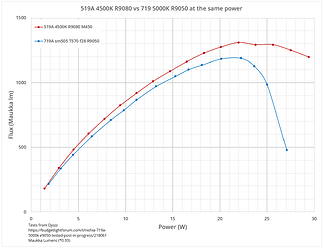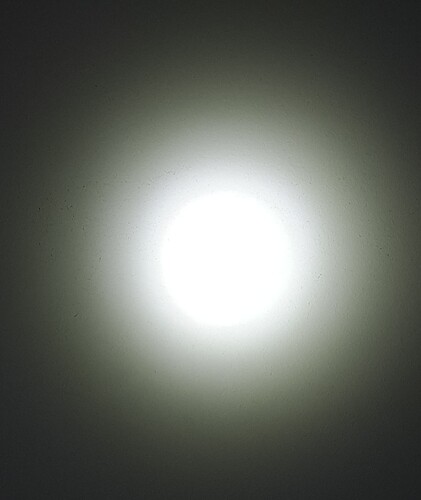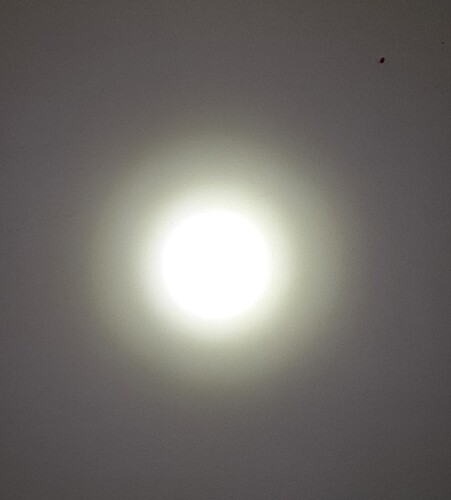2024-07-06
- Type: multi die (9x), domeless
- Bin: unknown
- Color group: unknown (3000 K)
- CRI: 90
- Rated voltage: 3 V
- Max. Forward current: 25,000 mA
- Max. Peak current: unknown
- Viewing angle: unknown
- Thermal resistance: unknown
- Max. Temperature Tj: unknown
Note: there is no official datasheet available!
The LED tested here was purchased from Kaidomain in June 2024. It is listed there as “SFN40 9x core 3 V”.
The SFN40 is an LED without a dome (called domeless). Its special feature is the 9 LED chips, which are arranged in a 3x3 grid with small gaps between them. There are no bonding wires or visible ESD elements. The phosphor has been applied on and slightly next to the LED chips. The individual LED chips are barely visible due to the thick phosphor layer.
The footprint corresponds to the familiar 5050 format. The SFN40 is compatible with normal XM or 5050 boards. The symmetrical housing means that standard centering gaskets for 5050 LEDs can be used.
The illuminated area is 12.1 mm² in size. Due to the light emitted from the side and the gaps between the individual LED chips, it is almost impossible to determine the exact illuminated area. It is noticeable that the phosphor has not been applied evenly to the illuminated surface; the light emitted at the outer corners has a higher color temperature. Depending on the optics used, this could have an effect on the beam.





- Maximum reached at 24 A, at this point 3295 lm @ 3.53 V
- Power at maximum 84.7 W
- Efficiency at maximum 38.9 lm/W



Data for 25 °C Tsp (at 85 °C the luminance values are around 13 % lower).
In the absence of an official data sheet and operating parameters, it is difficult to evaluate the performance. The maximum current of 25 A (!) specified by Kaidomain is not achieved even with excellent cooling at lab conditions. In a flashlight these maximum values would be even lower. The 5050 footprint is the primary limiting factor here due to the limited heat dissipation surface. It is likely that the stated 25 A does not represent the official maximum current. The thermal resistance is extremely low and should be somewhere in the range of 0.8 - 1.5 K/W, which is a very good value.
The Vf is extremely low due to the design. 3 V at around 7 A is the lowest forward voltage I have ever tested in a 3V class LED. Even the Luxeon MZ achieves around 3.1 V at 7 A. This is due to the 9 LED chips connected in parallel, each of which is only supplied with around 0.8 A at 7 A and therefore has a very low Vf.
The very low forward voltage means that the use of classic AMC7135-based drivers is no problem, and constant current regulation is guaranteed over a wide range of battery voltages.
The SFT-40 is very inefficient due to the very high CRI of 95. At its core, the SFN40 is quite powerful and offers quite high efficiency for warm white light.

Despite the unevenly applied phosphor and the light emitted by the sides of the LED chips, the beam is perfectly fine. (The yellowish tint may vary slightly depending on the screen, but on a calibrated OLED the color corresponds pretty much exactly to the yellow tint seen in real life).
There are no noticeable artifacts such as rings or donut holes. Using an OP reflector results in an absolutely harmonious and uniform beam with a large corona.

The tint is very yellow, which is to be expected due to the high duv of over 0.008. Despite the nominally high color rendering, the light is not pleasant at all. Colors appear washed out and less saturated, like if they are covered with some gray haze. If good light quality is required at 3000 K, emitters such as the Nichia 519A / 719A / B35AM or Luminus SFT-40 / SFT-70 are clearly preferable.
- Ra: 92
- R9: 61
- CCT: 3208 K
- duv: 0.0084
Briefly summarized: The SFN40 is a powerful LED with very low Vf, and quite high efficiency. It is compatible with 5050 footprints and provides a good light image in reflectors despite the 9 LED chips.
However, the light appears very yellow and the nominally high color rendering value is subjectively not very pleasant. In addition to a lack of sources of supply in the West, no official data sheets are available, which is why the use of this LED must be viewed with caution.
Thank you for reading this test. ![]()


